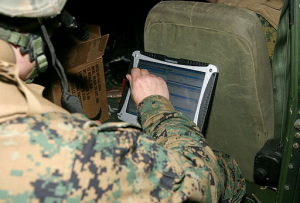Parylene and Ruggedization
Posted by Sean Horn
Tuesday, July 29, 2014 8:25
@ 8:25 AM
Ruggedized products are conceived for use in severe conditions, environments where excessive moisture or dryness, extreme temperatures, high levels of vibration, wind, or lack of atmosphere are the rule. Internal components of these specialized products require the same degree of ruggedization as exteriors.
Among products necessarily subjected to ruggedization processes during manufacture are:
- Embedded systems for military uses requiring dependable functionality through extreme conditions for an often extended duration;
- Mobile computers used for specialized purposes such as surveying, undersea or arctic exploration / research;
- Components and devices used for the aerospace industry, subjected to frequently exceptional pressures where aircraft / spacecraft are in flight; and
- A wide range of agricultural, industrial, telecommunications and healthcare products.
Parylene Conformal Coatings for Ruggedized Products
Parylene conformal coatings offer manufacturers an exceptional range of properties that support ruggedization for numerous products, providing added durability and enhanced performance. They are recommended for any products where reliable, dedicated electrical, biological or environmental protection is required. For instance, printed circuit boards (PCBs) and similar components benefit from parylene conformal coatings during ruggedization processes.
Parylene coatings generate:
- Resistance to shock, heavy vibrations, and environmental convulsions, natural or man-made,
- Capacities to withstand the effects of moisture, heat, dirt, hazardous chemicals, and other contaminants on component functioning, and
- Favorable properties combined with high dielectric strength.
To this end, parylene’s superior dielectrical properties ensure such coated components as PCBs are protected from electrical interference or signals that might disrupt their performance. In addition, parylene’s ability to be effectively applied in wafer-thin layers combines with its relative weightlessness to enhance its value for microelectromechanical systems’ (MEMS) applications.

Ruggedized Applications
- Keyboards for military / industrial use – Manufactured to MIL STD 810 standards, these keyboards / keypads rely on parylene coatings to protect their PCBs and similar essential components. Parylene protection is sufficient to withstand extreme acceleration, altitude, decompression, widely divergent temperatures and humidity, crash impacts and similar turbulence, thermal shock, and vibrations resulting from often prolonged use under these conditions. In addition, parylene can be applied as a shield to support MIL STD 461 standards, ensuring protection of electrical components against conditions leading to potential malfunction, such as electrostatic, magnetic or radio frequency interference. Military weaponry and field equipment similarly benefit from parylene applications to meet MIL STD 461 performance specifications.
- Rugged mobile devices – Parylene technologies can be applied to mobile computers, smartphones and tablets, providing ruggedized protection for sufficient to ensure real time, on-the-go connectivity. Parylene suitably safeguards them from dust, water and rain, exceptional vibrations and shock, falls, accidental drops or major impact, for use at varying altitudes or under extreme weather conditions. Rugged cameras, device connectors and bonding technology also make use of parylene coatings for similar purposes.
- Automotive products – Sensors, controls, and polymer / elastomer seals used in automobiles can be subjected to harsh operating conditions, wherein ruggedization generates performance advantages – less chance of malfunction or breakdown in an environment typified by changing thermal conditions and exposure to a variety of potentially corrosive engine liquids. Parylene coatings also provide superb component protection for automotive computers used to manage tractor-trailer fleet operations characterized by high vehicular-mileage; dependable communications platforms are mandatory for integrated GPS vehicle tracking, voice and data communications (WiFi / Bluetooth), and vehicle telemetry.
- Aerospace and Commercial Products – Comparable to automotive applications, parylene use for aerospace / commercial products eliminates unwanted adhesion on silicon materials, interfering with their appropriate use during operation. At the same time, parylene enhances gasket-adhesion, as well as the elastomer-adhesion, to metals and polymers. Fiber optic components for aerospace and commercial purposes also benefit from parylene-coating processes, where ruggedized communications are required to meet high standard MIL 883 / 810, ARINC 801 – 806 or 818, or other industrial specifications. Transceivers and optical test equipment for commerce, industry an aerospace use ruggedized fiber optic cables treated with parylene, as do military and IT applications.
Conclusion
Designed to withstand harsh environments, ruggedized products are increasingly numerous. They are manufactured to meet challenging performance standards for industrial, defense, aerospace, and commercial applications.
Comments
Homepage 4/17/2020. 10:17:10 AM
... [Trackback] [...] Informations on that Topic: blog.paryleneconformalcoating.com/whats-the-difference-between-potting-and-conformal-coating/ [...]

londondrugscanada.bigcartel.comlondon-drugs 4/17/2020. 10:17:10 AM
cialis uk https://londondrugscanada.bigcartel.com/london-drugs This is nicely expressed. !